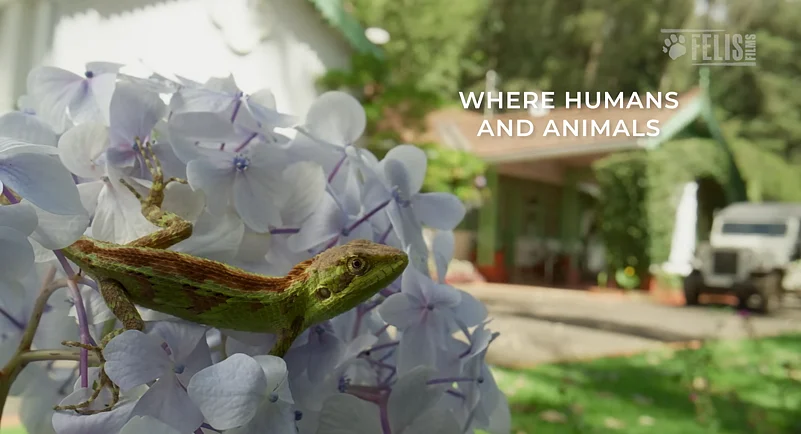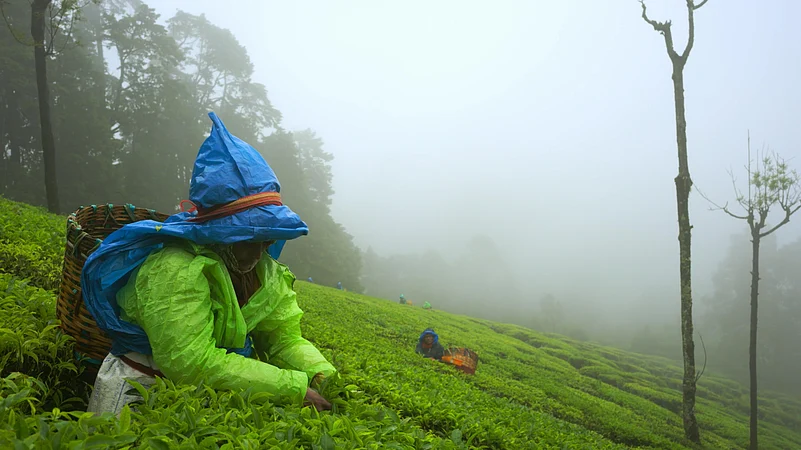
The film maps the movement and rhythm of endemic life in the Nilgiri Mountains across the Western Ghats.
It reveals the limitations of organising perception around human existence.
The film envisages the memory of Earth’s changes across geological epochs.
Sandesh Kadur’s nature documentary Nilgiris: A Shared Wilderness (2024)—released last month across limited theatres in Indian metropolises—presents an intense and sobering cinematic experience of our first Biosphere Reserve. The film questions and attempts to reorient our perceptive anchors to the world. By mapping the movement and rhythm of endemic life in the Nilgiri Mountains across the Western Ghats, Kadur reveals the limitations of organising perception around human existence. Unaccustomed and untrained, human eyes twitch at the prospect of gauging the expanse of non-human sentience.
This is certainly the case in the contemporary capitalist-industrial complex, where humans are marked by a mechanical stupor. Caught in the thralls of technological progress, they have been estranged not only from society but from their first home—nature. However, Nilgiris opts to maintain a critical distance from all such human affairs; this disinterest renders homo sapiens dull, in comparison to the vibrant multiplicity of nature and its wilderness.

Anytime the camera rushes past their activities, it registers merely speed—an extreme sense of motion that remains incomprehensible. Thus, what gets imprinted is a human behavioural pattern marked by delirium and restlessness. Though there is no explicit connection made, this delirium is subtly linked to the historical-political acts of appropriating and transforming the landscape and its habitats through colonialism, tea plantation, development of trade and tourism over the last two centuries. Rather than seeing these changes as singular events, the film subsumes and naturalises these processes into the biosphere and its dynamic natural history.
Populated with a diverse range of flora and fauna—including but not limited to Chital and Sambar deer,lion-tailed macaques, Nilgiri bison (Gaur) and sloth bears, along with Malabar grey hornbills, parakeets, and pond herons—the Reserve is also home to six hundred species of flowering plants. One such species of the rhododendron, rose-like in its deep red hue, survives as a relic from the Pleistocene glacial period. Its nearest family member is found two thousand kilometres away, in the Himalayas. In one flower, the film signals the landscape folding and forming, connecting the Western Ghats in the south to the Himalayas in the north. In one life form, we envisage the memory of Earth’s changes across geological epochs.

Traversing through the ancient waters of the Moyar River, the camera takes us like a bird over the length of its stream, hidden and cascading deep inside the forest. The river gets its name from the word “Moyam”in Tamil, meaning “that which disappears” — attesting to the river’s ability to get buried under vegetation during the summer season. Every life that has evolved in its nourishing waters carries the geological footprint of the Moyar gorge. As the camera ascends higher, revealing the mountain peaks shrouded in white mists with their dense cloud cover, the mosaic of light and shadow sparkles upon the grasslands below and its tiny creatures.
Shortly after, the film cuts to a majestic Nilgiri tahr standing at the precipice of the mountain with a self-assured authority, even as it faces a bottomless pit. Its existence at dizzying heights, where human lungs might collapse, serves a purpose—it keeps the wild goat safe from predators.Through the Nilgiri tahr, the documentary forces us to imagine how life can survive on the edge of nothingness. Nilgiris is a vertical habitat; in one sequence, we see a tiger hunt a deer from above rather than behind. In this documentary, the story of predator and prey unfolds not horizontally, but vertically.

Its most powerful moments lie in showing how the biosphere contains a multitude of spatial relationships at once. It exhibits a fragile, albeit unbroken link, between the animal and the terrain to which they adapt and evolve, from one generation to another. The landscape appears magical—not only does it hold the relationships and networks among a myriad of species, but it actively transforms them. The landscape does not appear as a passive backdrop; it presents the theatre of life itself.
Like the weaving of spatial networks in the biosphere, each species with its distinct life cycle forms intricate interconnecting temporalities of the Earth. Different from the kind of standardised time governing human subjects, time in the biosphere perforates and fragments as one set of temporality flows into another in the co-existence of the organisms.
Time unfolds as a panorama—with terrains changing and transforming across centuries, witnessing cycles of creation and destruction, life and decay. Here, time is vast and immense, and human life appears as a blip. The film, while attending to the life cycle of dragonflies—particularly the voracious predatory skills of its larval form (nymph) feasting on tadpoles— imbues the landscape with a sense of duration tied to the dragonfly’s metamorphosis. In a remarkable process of co-evolution, the microscopic wasps and the enormous fig trees are bound by the same timeline, for each fig species gets pollinated by its own wasp species. The evolution and sustenance of life feels magical as if every organism has its preordained place in the microcosm of the biosphere.

As the camera rests inside a tree hole, it captures the perspective of an infant hornbill chick; from a wooden cavity, we see the day sky turn into a starry night. As the young bird matures, its distinctively large and curved beak protruding from the tree cavity, she must now learn to fly. Food earlier supplied by her parents now becomes a bait to draw her outside. She tries, crashes, but ultimately rises up towards her parents. The attention demanded by these processes and beginnings of life involves total absorption, a form of spiritual commitment, as well as an admission of a shared futurity from the human beings.
Somewhere in the middle of the documentary, a speeding car—oblivious of its passage through the Nilgiri mountains—almost kills a bison. But, this near-miss collision gets suspended on the screen, promptingthe film to withdraw into reverse gear. We are pulled into a vortex of images and sounds, briefly dragging us into pre-historic times of cave-dwellers, before hurling back into the present. In this to and fro, a turbulent montage of the entire human history emerges, where the rapid growth of industrialisation and incessant consumption mark the last two hundred years.

Decentering the humans, the camera tracks, in a fast-forward motion, the journey of a carrot from harvesting, trading to consuming—a critical spin on the “farm to table” marketing phrase, where everything exists solely for human consumption. The commentary is obvious here: human vision cannot perceive the carrot as anything but an industrial commodity.
Against the dominion of this human-centric vision, Sandesh Kadur’s documentary refuses to surrender to the melancholic knowledge of humankind’s encroachments upon nature. Nilgiris: A Shared Wilderness is unwaveringly loyal in paying attention to non-human life in the biosphere.
Soumya Choudhury is a doctoral student at the Centre for English Studies, Jawaharlal Nehru University, New Delhi.





















